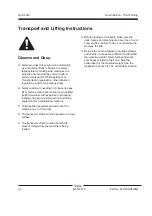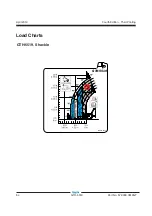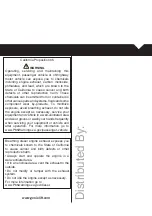
April 2019
Fourth Edition - Third Printing
Part No.
57.0009.0619GT
GTH-5519 53
Lifting a Suspended Load
Verify that the landing point is level and can safely
support the load.
Properly secure the attachment to the telehandler
Level the frame on the telehandler.
Rig the load as outlined in OSHA 29 CFR
1926.1401, 1926.1404, and 1926.1425, keeping
the heaviest part of the load as close to the
attachment as practical.
Tether the load to restrict movement.
Ask a signal person to assist with lifting the load if
visibility will be obstructed at the point of operation.
Make sure that the signal person remains in
constant communication and is in visual contact at
all times with the operator.
With the boom retracted as far as practical, slowly
and gradually raise the boom and load, making
sure to keep the load and boom as close to the
ground as practical.
Be sure that all boom and attachment movements
are performed as slow as practical to avoid
swinging of the load.
Traveling
Be sure that the path of travel is level and capable
of supporting the telehandler with its load.
Keep the boom, and load, as low as practical while
maintaining visibility in the direction of travel.
Ask a signal person to assist with your travel if
visibility will be obstructed in the direction of travel.
Crush or Collision Hazard. Make sure that the
signal person remains in constant communication
and be in visual contact at all times with the
operator.
Only make adjustments to the load after bringing
the telehandler to a complete stop.
Start, stop, travel and turn slowly to prevent the
load from becoming unstable or swinging.
Do not travel faster than walking speed (<2 mph /
3.2 km/h).
Attachments



























